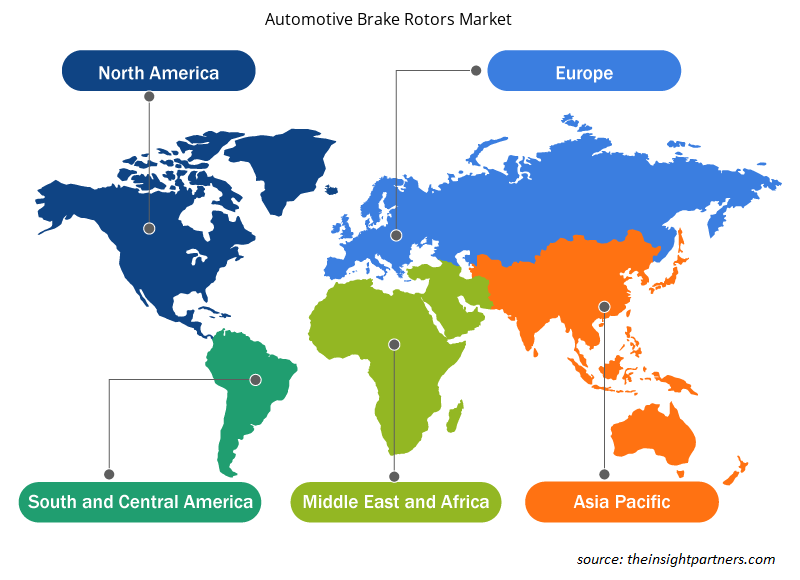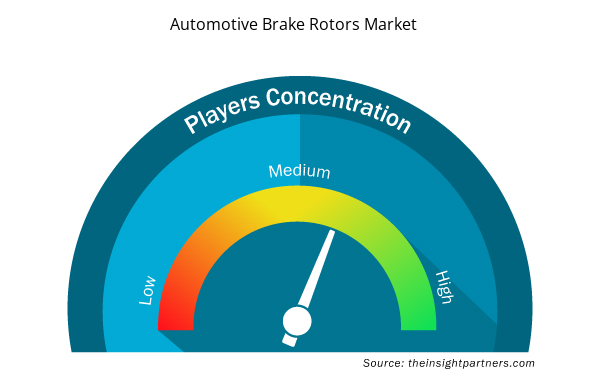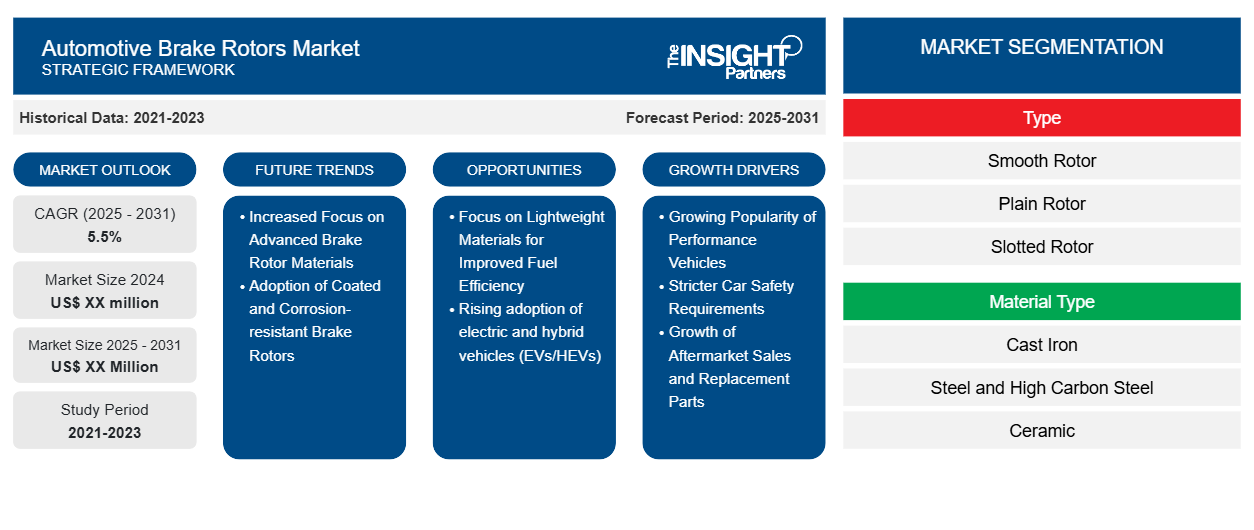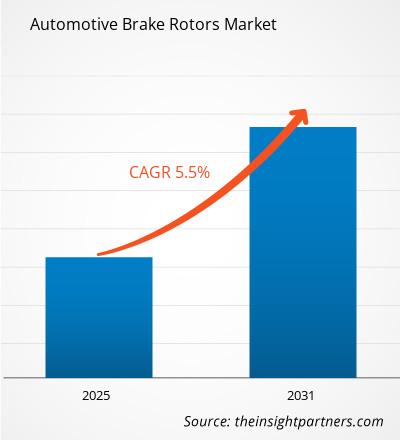Se espera que el mercado de rotores de freno automotrices registre una CAGR del 5,5 % entre 2023 y 2031, con un tamaño de mercado que se expandirá de US$ XX millones en 2023 a US$ XX millones en 2031.
El mercado de rotores de freno para automóviles cubre el análisis por tipo (rotor liso, rotor simple, rotor ranurado, rotor perforado, otros), por tipo de material (hierro fundido, acero y acero con alto contenido de carbono, cerámica, otros), por tipo de vehículo (automóviles de pasajeros, vehículos ligeros, vehículos comerciales medianos y pesados) y geografía (América del Norte, Europa, Asia Pacífico, Medio Oriente y África, y América del Sur y Central)
Propósito del Informe
El informe Automotive Brake Rotors Market de The Insight Partners tiene como objetivo describir el panorama actual y el crecimiento futuro, los principales factores impulsores, los desafíos y las oportunidades. Esto proporcionará información a diversas partes interesadas del negocio, como:
- Proveedores/fabricantes de tecnología: Para comprender la dinámica cambiante del mercado y conocer las oportunidades potenciales de crecimiento, lo que les permitirá tomar decisiones estratégicas informadas.
- Inversionistas: Realizar un análisis exhaustivo de tendencias sobre la tasa de crecimiento del mercado, las proyecciones financieras del mercado y las oportunidades que existen en toda la cadena de valor.
- Órganos reguladores: Regular las políticas y vigilar las actividades del mercado con el objetivo de minimizar los abusos, preservar la confianza de los inversores y defender la integridad y la estabilidad del mercado.
Segmentación del mercado de rotores de freno para automóviles
Tipo
- Rotor liso
- Rotor liso
- Rotor ranurado
- Rotor perforado
- Otros
Tipo de material
- Hierro fundido
- Acero y acero de alto carbono
- Cerámico
- Otros
Tipo de vehículo
- Automóviles de pasajeros
- Vehículos ligeros
- Vehículos comerciales medianos y pesados
Geografía
- América del norte
- Europa
- Asia-Pacífico
- América del Sur y Central
- Oriente Medio y África
Geografía
- América del norte
- Europa
- Asia-Pacífico
- América del Sur y Central
- Oriente Medio y África
Personalice este informe según sus necesidades
Obtendrá personalización en cualquier informe, sin cargo, incluidas partes de este informe o análisis a nivel de país, paquete de datos de Excel, así como también grandes ofertas y descuentos para empresas emergentes y universidades.
- Obtenga las principales tendencias clave del mercado de este informe.Esta muestra GRATUITA incluirá análisis de datos, desde tendencias del mercado hasta estimaciones y pronósticos.
Factores impulsores del crecimiento del mercado de rotores de freno para automóviles
- Creciente popularidad de los vehículos de alto rendimiento: la creciente popularidad de los vehículos de alto rendimiento, como los coches deportivos, los automóviles de lujo y los SUV de alta gama, es otro factor clave del mercado de los discos de freno. Los vehículos de alto rendimiento suelen necesitar sistemas de freno mejorados con mayor potencia de frenado, mayor resistencia al calor y una vida útil más prolongada. Debido a que estos vehículos utilizan con frecuencia materiales de primera calidad, como compuestos de carbono y rotores ventilados, la necesidad de discos de freno especializados y de alto rendimiento está aumentando. Esta tendencia es especialmente notoria en mercados como América del Norte y Europa, donde las ventas de vehículos de alto rendimiento están aumentando rápidamente.
- Requisitos de seguridad para vehículos más estrictos: a medida que los gobiernos de todo el mundo endurecen los requisitos de seguridad para los vehículos, el rendimiento y la seguridad de los frenos se han convertido en una prioridad máxima. Estas normas, que con frecuencia incluyen altas exigencias en cuanto al rendimiento de los frenos, requieren sistemas de frenos mejorados y más duraderos, incluidos los discos de freno. La presión para lograr estándares de seguridad vehicular más estrictos en todas las regiones, especialmente en mercados desarrollados como Europa y América del Norte, está impulsando la necesidad de sistemas de frenos mejorados, lo que a su vez impulsa la demanda de discos de freno de alta calidad.
- Crecimiento de las ventas de repuestos y piezas de repuesto en el mercado de accesorios: el crecimiento del segmento de repuestos respalda la expansión del mercado de rotores de freno para automóviles. A medida que envejece la flota mundial de vehículos, aumenta la demanda de rotores de freno de repuesto. Los propietarios de vehículos deben reparar rotores desgastados o dañados de forma regular, lo que crea una necesidad constante de piezas de freno de repuesto. Además, los usuarios que desean mejorar el rendimiento de frenado de su vehículo, en particular para vehículos de alto rendimiento o aquellos con modificaciones a medida, con frecuencia buscan rotores especiales en el mercado de repuestos. Esta demanda continua de componentes de repuesto crea un potencial significativo para que los fabricantes de rotores de freno atiendan tanto al consumidor general como al mercado de repuestos de alto rendimiento.
Tendencias futuras del mercado de discos de freno para automóviles
- Mayor enfoque en materiales avanzados para rotores de freno: la industria de rotores de freno para automóviles está experimentando un cambio hacia nuevos materiales que mejoran el rendimiento, la durabilidad y la eficiencia en términos de peso. Los rotores de compuestos de carbono, cerámicos y de fundición con alto contenido de carbono están ganando popularidad porque son más resistentes al calor, duran más y pesan menos que los rotores de fundición típicos. Los rotores de cerámica y carbono, por ejemplo, se están volviendo cada vez más populares en automóviles de alto rendimiento y de lujo debido a su rendimiento de frenado superior y su capacidad para soportar temperaturas más elevadas. La transición continua hacia materiales livianos y de alto rendimiento seguirá siendo una tendencia importante en la industria.
- Adopción de rotores de freno revestidos y resistentes a la corrosión: Otra tendencia importante en el mercado de rotores de freno para automóviles es el uso creciente de rotores revestidos y resistentes a la corrosión. Los rotores de freno están sujetos a condiciones ambientales extremas, como humedad, sal y productos químicos de la carretera, que pueden provocar óxido y corrosión. Los fabricantes están reaccionando a este desafío diseñando rotores con revestimientos protectores, como superficies revestidas de zinc o cerámica, para aumentar su longevidad y rendimiento, especialmente en áreas con condiciones climáticas adversas. Estos revestimientos ayudan a aumentar la resistencia a la corrosión del rotor, mejorando la seguridad general y la durabilidad del sistema de frenado del vehículo.
Oportunidades de mercado para rotores de frenos automotrices
- Enfoque en materiales livianos para mejorar la eficiencia de combustible: los fabricantes de discos de freno para automóviles tienen una oportunidad significativa de desarrollar discos livianos compuestos de materiales innovadores como compuestos de carbono, aluminio o aleaciones de titanio. Los discos de freno livianos pueden reducir en gran medida el peso total del vehículo, lo que resulta en una mayor eficiencia de combustible y rendimiento. Con un enfoque global en reducir las emisiones de carbono y mejorar el ahorro de combustible, los discos de freno livianos están ganando popularidad, particularmente para vehículos eléctricos, donde reducir el peso del vehículo es fundamental para ampliar la autonomía de conducción. Los fabricantes que inviertan en investigación y desarrollo de estos materiales sofisticados estarán bien posicionados para aprovechar esta oportunidad.
- Aumento de la adopción de vehículos eléctricos e híbridos (VE/VEH): el aumento del uso de vehículos eléctricos (VE) y vehículos eléctricos híbridos (VEH) abre nuevas posibilidades para los fabricantes de rotores de freno. Los VE y los VEH incorporan con frecuencia sistemas de frenado regenerativo, que ahorran desgaste en los componentes de freno estándar. Sin embargo, estos vehículos siguen necesitando rotores de freno, especialmente en situaciones de emergencia y cuando el frenado regenerativo es insuficiente. Además, los sistemas de frenado de los VE deben desarrollarse específicamente para soportar el peso del vehículo, las necesidades de rendimiento y las capacidades de frenado regenerativo. Los fabricantes pueden aprovechar esta tendencia fabricando rotores de freno ligeros, robustos y energéticamente eficientes para vehículos eléctricos e híbridos.
Perspectivas regionales del mercado de rotores de freno para automóviles
Los analistas de Insight Partners explicaron en detalle las tendencias y los factores regionales que influyen en el mercado de rotores de freno para automóviles durante el período de pronóstico. Esta sección también analiza los segmentos y la geografía del mercado de rotores de freno para automóviles en América del Norte, Europa, Asia Pacífico, Oriente Medio y África, y América del Sur y Central.

- Obtenga datos regionales específicos para el mercado de rotores de freno para automóviles
Alcance del informe de mercado de rotores de freno para automóviles
| Atributo del informe | Detalles |
|---|---|
| Tamaño del mercado en 2023 | XX millones de dólares estadounidenses |
| Tamaño del mercado en 2031 | US$ XX millones |
| CAGR global (2023 - 2031) | 5,5% |
| Datos históricos | 2021-2022 |
| Período de pronóstico | 2024-2031 |
| Segmentos cubiertos | Por tipo
|
| Regiones y países cubiertos | América del norte
|
| Líderes del mercado y perfiles de empresas clave |
|
Densidad de actores del mercado de rotores de freno para automóviles: comprensión de su impacto en la dinámica empresarial
El mercado de discos de freno para automóviles está creciendo rápidamente, impulsado por la creciente demanda de los usuarios finales debido a factores como la evolución de las preferencias de los consumidores, los avances tecnológicos y una mayor conciencia de los beneficios del producto. A medida que aumenta la demanda, las empresas amplían sus ofertas, innovan para satisfacer las necesidades de los consumidores y aprovechan las tendencias emergentes, lo que impulsa aún más el crecimiento del mercado.
La densidad de actores del mercado se refiere a la distribución de las empresas o firmas que operan dentro de un mercado o industria en particular. Indica cuántos competidores (actores del mercado) están presentes en un espacio de mercado determinado en relación con su tamaño o valor total de mercado.
Las principales empresas que operan en el mercado de discos de freno para automóviles son:
- Frenos EBC
- Robert Bosch GmbH
- SGL Carbon
- Brembo SpA
- Industria de frenos Akebono Co., Ltd.
Descargo de responsabilidad : Las empresas enumeradas anteriormente no están clasificadas en ningún orden particular.

- Obtenga una descripción general de los principales actores clave del mercado de rotores de freno para automóviles
Puntos de venta clave
- Cobertura integral: el informe cubre de manera integral el análisis de productos, servicios, tipos y usuarios finales del mercado de rotores de freno automotrices, proporcionando un panorama holístico.
- Análisis de expertos: el informe se compila sobre la base de un profundo conocimiento de expertos y analistas de la industria.
- Información actualizada: El informe asegura relevancia comercial debido a su cobertura de información reciente y tendencias de datos.
- Opciones de personalización: este informe se puede personalizar para satisfacer los requisitos específicos del cliente y adaptarse adecuadamente a las estrategias comerciales.
Por lo tanto, el informe de investigación sobre el mercado de rotores de freno para automóviles puede ayudar a abrir camino para descifrar y comprender el escenario de la industria y las perspectivas de crecimiento. Si bien puede haber algunas preocupaciones válidas, los beneficios generales de este informe tienden a superar las desventajas.
- Análisis histórico (2 años), año base, pronóstico (7 años) con CAGR
- Análisis PEST y FODA
- Tamaño del mercado Valor/volumen: global, regional, nacional
- Industria y panorama competitivo
- Conjunto de datos de Excel


- Water Pipeline Leak Detection System Market
- Gas Engine Market
- Grant Management Software Market
- Fill Finish Manufacturing Market
- Electronic Signature Software Market
- Nitrogenous Fertilizer Market
- Extracellular Matrix Market
- Visualization and 3D Rendering Software Market
- Dealer Management System Market
- Vaginal Specula Market

Report Coverage
Revenue forecast, Company Analysis, Industry landscape, Growth factors, and Trends

Segment Covered
This text is related
to segments covered.

Regional Scope
North America, Europe, Asia Pacific, Middle East & Africa, South & Central America

Country Scope
This text is related
to country scope.
Preguntas frecuentes
The report can be delivered in PDF/PPT format; we can also share excel dataset based on the request.
Some of the customization options available based on the request are an additional 3-5 company profiles and country-specific analysis of 3-5 countries of your choice. Customizations are to be requested/discussed before making final order confirmation, as our team would review the same and check the feasibility.
The major players in the market includes Brembo, Continental AG, Robert Bosch GmbH, Akebono Brake Industry, ZF Friedrichshafen AG, Aisin Ltd., HL Command, TRW Automotive, Autoliv, Inc., Eaton Corporation, and Others.
The Automotive Brake Rotors Market is estimated to witness a CAGR of 5.5% from 2023 to 2031
High manufacturing cost of the automotive brake rotors hinders the market growth.
The major factors driving the automotive brake rotors market are: Rising automotive production and sale across the globe with increasing demand for safety in the automotive sector drives the market growth.
Trends and growth analysis reports related to Automotive and Transportation : READ MORE..
1. EBC Brakes
2. Robert Bosch GmbH
3. SGL Carbon
4. Brembo S.p.A.
5. Akebono Brake Industry Co., Ltd.
6. Rotora
7. Federal-Mogul Corporation
8. Surface Transforms PLC
9. AISIN CORPORATION
10. CENTRIC PARTS
The Insight Partners performs research in 4 major stages: Data Collection & Secondary Research, Primary Research, Data Analysis and Data Triangulation & Final Review.
- Data Collection and Secondary Research:
As a market research and consulting firm operating from a decade, we have published and advised several client across the globe. First step for any study will start with an assessment of currently available data and insights from existing reports. Further, historical and current market information is collected from Investor Presentations, Annual Reports, SEC Filings, etc., and other information related to company’s performance and market positioning are gathered from Paid Databases (Factiva, Hoovers, and Reuters) and various other publications available in public domain.
Several associations trade associates, technical forums, institutes, societies and organization are accessed to gain technical as well as market related insights through their publications such as research papers, blogs and press releases related to the studies are referred to get cues about the market. Further, white papers, journals, magazines, and other news articles published in last 3 years are scrutinized and analyzed to understand the current market trends.
- Primary Research:
The primarily interview analysis comprise of data obtained from industry participants interview and answers to survey questions gathered by in-house primary team.
For primary research, interviews are conducted with industry experts/CEOs/Marketing Managers/VPs/Subject Matter Experts from both demand and supply side to get a 360-degree view of the market. The primary team conducts several interviews based on the complexity of the markets to understand the various market trends and dynamics which makes research more credible and precise.
A typical research interview fulfils the following functions:
- Provides first-hand information on the market size, market trends, growth trends, competitive landscape, and outlook
- Validates and strengthens in-house secondary research findings
- Develops the analysis team’s expertise and market understanding
Primary research involves email interactions and telephone interviews for each market, category, segment, and sub-segment across geographies. The participants who typically take part in such a process include, but are not limited to:
- Industry participants: VPs, business development managers, market intelligence managers and national sales managers
- Outside experts: Valuation experts, research analysts and key opinion leaders specializing in the electronics and semiconductor industry.
Below is the breakup of our primary respondents by company, designation, and region:

Once we receive the confirmation from primary research sources or primary respondents, we finalize the base year market estimation and forecast the data as per the macroeconomic and microeconomic factors assessed during data collection.
- Data Analysis:
Once data is validated through both secondary as well as primary respondents, we finalize the market estimations by hypothesis formulation and factor analysis at regional and country level.
- Macro-Economic Factor Analysis:
We analyse macroeconomic indicators such the gross domestic product (GDP), increase in the demand for goods and services across industries, technological advancement, regional economic growth, governmental policies, the influence of COVID-19, PEST analysis, and other aspects. This analysis aids in setting benchmarks for various nations/regions and approximating market splits. Additionally, the general trend of the aforementioned components aid in determining the market's development possibilities.
- Country Level Data:
Various factors that are especially aligned to the country are taken into account to determine the market size for a certain area and country, including the presence of vendors, such as headquarters and offices, the country's GDP, demand patterns, and industry growth. To comprehend the market dynamics for the nation, a number of growth variables, inhibitors, application areas, and current market trends are researched. The aforementioned elements aid in determining the country's overall market's growth potential.
- Company Profile:
The “Table of Contents” is formulated by listing and analyzing more than 25 - 30 companies operating in the market ecosystem across geographies. However, we profile only 10 companies as a standard practice in our syndicate reports. These 10 companies comprise leading, emerging, and regional players. Nonetheless, our analysis is not restricted to the 10 listed companies, we also analyze other companies present in the market to develop a holistic view and understand the prevailing trends. The “Company Profiles” section in the report covers key facts, business description, products & services, financial information, SWOT analysis, and key developments. The financial information presented is extracted from the annual reports and official documents of the publicly listed companies. Upon collecting the information for the sections of respective companies, we verify them via various primary sources and then compile the data in respective company profiles. The company level information helps us in deriving the base number as well as in forecasting the market size.
- Developing Base Number:
Aggregation of sales statistics (2020-2022) and macro-economic factor, and other secondary and primary research insights are utilized to arrive at base number and related market shares for 2022. The data gaps are identified in this step and relevant market data is analyzed, collected from paid primary interviews or databases. On finalizing the base year market size, forecasts are developed on the basis of macro-economic, industry and market growth factors and company level analysis.
- Data Triangulation and Final Review:
The market findings and base year market size calculations are validated from supply as well as demand side. Demand side validations are based on macro-economic factor analysis and benchmarks for respective regions and countries. In case of supply side validations, revenues of major companies are estimated (in case not available) based on industry benchmark, approximate number of employees, product portfolio, and primary interviews revenues are gathered. Further revenue from target product/service segment is assessed to avoid overshooting of market statistics. In case of heavy deviations between supply and demand side values, all thes steps are repeated to achieve synchronization.
We follow an iterative model, wherein we share our research findings with Subject Matter Experts (SME’s) and Key Opinion Leaders (KOLs) until consensus view of the market is not formulated – this model negates any drastic deviation in the opinions of experts. Only validated and universally acceptable research findings are quoted in our reports.
We have important check points that we use to validate our research findings – which we call – data triangulation, where we validate the information, we generate from secondary sources with primary interviews and then we re-validate with our internal data bases and Subject matter experts. This comprehensive model enables us to deliver high quality, reliable data in shortest possible time.


 Obtenga una muestra gratuita de este informe
Obtenga una muestra gratuita de este informe